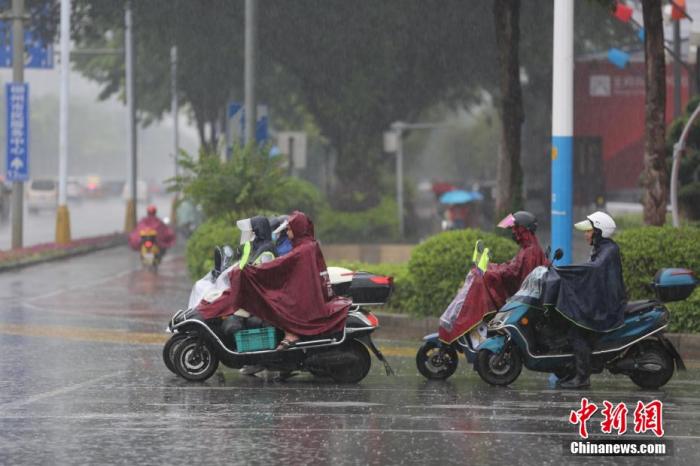China News Service, May 11th, a comprehensive report, on the 10th, the southern rainfall entered the strongest period of this round of precipitation.
It is worth noting that this heavy rainfall process is the strongest rainfall since the flood season this year, involving a wide range, long duration, large cumulative rainfall, and high disaster risk. The local daily rainfall may exceed the historical extreme value for the same period.
The Central Meteorological Observatory continued to issue a yellow rainstorm warning at 6:00 on the 11th.
Guangzhou, Zhuhai, Zhongshan and other places have suspended classes; affected by heavy rain, some trains in Shenzhen have been suspended and adjusted.
On the morning of May 9, heavy rainfall hit Liuzhou City, Guangxi, and citizens were riding on the road wearing rain gear.
Photo by Meng Mingming
Multiple departments issued warning information
At 6:00 on May 11, the Central Meteorological Observatory continued to issue a yellow rainstorm warning: It is expected that from 8:00 on May 11 to 8:00 on 12, western and central and southern Guangxi, central and southern Guangdong, central and southern Fujian, and southwestern Guizhou, eastern Yunnan, There were heavy to heavy rains in parts of central and northern Shanxi and other places. Among them, there were heavy rains (100-180 mm) in parts of southern Guangdong, western and southeastern Guangxi, and southeastern Yunnan.
Some of the above-mentioned areas are accompanied by short-term heavy precipitation (the maximum hourly rainfall is 20-50 mm, and the local area can exceed 60 mm), and there are local strong convective weather such as thunderstorms and strong winds.
Forecast map of heavy rainfall areas across the country (08:00 on May 11th - 08:00 on May 12th)
Previously, the Ministry of Natural Resources and the China Meteorological Administration jointly issued a geological disaster meteorological risk warning at 18:00 on May 10: It is expected that from 20:00 on the 10th to 20:00 on the 11th, geological disasters will occur in the southeast of Guangxi, the northeast and southeast of Guangxi. High risk (yellow alert).
Local residents are advised to take precautions against geological disasters caused by precipitation, especially in the areas near the hidden danger points of geological disasters.
The Ministry of Water Resources and the China Meteorological Administration jointly issued an orange flash flood disaster weather warning at 18:00 on May 10: It is expected that from 20:00 on the 10th to 20:00 on the 11th, the central and western Fujian, southeastern Jiangxi, northeastern, central and southwestern Guangdong, There is a high possibility of mountain torrent disasters in parts of southeastern Guangxi and other places (yellow warning), among which local flash flood disasters in southeastern Guangxi and other places are very likely (orange warning).
All localities are advised to do a good job in real-time monitoring, flood prevention and early warning, and transfer to avoid risks.
The Yangtze River Water Conservancy Commission launched a level IV emergency response to flood and drought disaster prevention at 20:00 on the 10th.
This is also the first time that the Yangtze River Commission has launched a level IV emergency response to flood and drought disaster prevention this year.
According to the relevant person in charge of the Yangtze River Committee, from 8 to 19:00 on May 10, a total of 5 stations in the Yangtze River Basin exceeded the warning water level. The stations that exceeded the warning level were mainly distributed in the Xiangjiang River in the Dongting Lake water system and the Ganjiang River in the Poyang Lake water system, and the exceeded warning range was 0.18 -0.85m.
Meteorological experts reminded that due to heavy rainfall, secondary disasters such as flash floods, landslides, and debris flows may occur in Guangdong, Guangxi, Fujian, Jiangxi and other places. Convective weather.
The public is requested to avoid going out during periods of heavy rainfall as much as possible, and to prevent the possible adverse effects of urban and rural waterlogging on production, life and transportation.
On the morning of May 9, heavy rainfall hit Liuzhou City, Guangxi, and citizens walked in the rain.
Photo by Meng Mingming
Many places in Guangdong suspended classes, some trains in Shenzhen suspended
According to the Guangdong Meteorological Observatory, as of 7:13 today, 11 red rainstorm, 8 orange rainstorm and 29 yellow rainstorm warning signals are in effect in Guangdong; Promoted to level II.
From 0:00 to 6:00 today, two towns and streets in Guangdong Province experienced heavy rains of more than 250 mm, and 43 towns and streets experienced heavy rains of 100-250 mm.
In response to the various adverse effects that may be caused by heavy rainfall, the Guangzhou Flood Control, Drought and Wind Prevention Headquarters issued a notice yesterday. From now until 24:00 on the 12th, classes in primary and secondary schools and kindergartens in Guangzhou will be suspended, and work from home is advocated; The rainfall has approached or reached 100 mm, the red warning is in effect, and all primary and secondary schools and kindergartens in the city have been notified to suspend classes.
In addition, Jiangmen City and Zhongshan City have also announced the closure of primary and secondary schools and kindergartens in the city.
In terms of transportation, affected by the heavy rain in Guangdong, Guangzhou Railway Group started flood control emergency response at 18:00 on May 10.
From May 11 to 13, some trains passing through Beijing-Guangzhou Line, Jiang-Zhanjiang Line, Guangzhou-Zhuhai Intercity, Guangzhou-Shenzhen Intercity, Fo-Zhao-Sui-Shenzhen Intercity, Hangzhou-Shenzhen Line and other trains will be suspended or adjusted to run sections.

